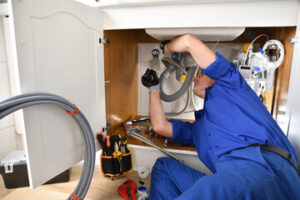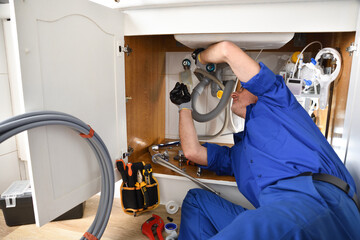Clogged drains create the perfect environment for bacteria, mold, and insects to thrive. These contaminants seep into your home and cause serious health problems. Drain Cleaning Perth prevents this and keeps your home healthy.
Keeping your drains clean prevents costly plumbing repairs. Backed up drains can also smell very unpleasant, which is avoided with regular drain cleaning.
Drain clogs not only interfere with water flow but can also lead to costly pipe repairs and other plumbing problems. Regular drain cleaning can help prevent these issues and keep your home’s plumbing running smoothly.
Common causes of clogged drains include food waste, hair, grease, and foreign objects. Educating household members on what can and cannot go down the drain can help prevent these issues. In addition, installing drain screens or strainers can trap these items before they enter your pipes. Grease and oil can solidify in your pipes, creating a hard-to-remove blockage.
Using your garbage disposal to dispose of grease can help prevent these clogs as well. However, if these clogs persist, it’s best to contact a professional plumber for drain cleaning and maintenance services.
Other causes of clogged drains include sanitary products and children’s toys that can get lodged in sink or tub openings. In addition, identifying the early signs of a clogged drain, such as slow drainage or gurgling sounds, can save you from experiencing more serious and expensive problems down the road.
Having your drains cleaned on a routine basis can also prevent corrosion and minor cracks in your pipes, which can lead to severe sewage backups and other serious plumbing problems. During the drain cleaning process, your plumber can inspect your pipes for these issues and take the necessary steps to address them before they become worse.
Prevents Health Issues
Clogged drains create an environment that fosters bacteria, fungus, and other pathogens that can lead to various health issues for household members. They also contribute to a foul smell in the house, which can affect indoor air quality. Regular drain cleaning prevents these issues and ensures a healthy living environment.
Regular drain cleaning helps extend the lifespan of your plumbing system by preventing clogs and pipe corrosion. It also keeps drains functioning efficiently, which reduces the strain on the pipes and plumbing fixtures. This can help avoid future problems and costly repairs, as well as prevent sewage from backing up into your home.
To minimize the risk of clogs, use drain strainers to catch debris and hair before it enters your plumbing pipes. Additionally, don’t pour grease or oil down the drain; let it solidify and then dispose of it in the trash can. You should also avoid putting any food scraps down the drain, as they can create long-lasting grime that sticks to pipes.
If you must use chemical drain cleaners, always follow the manufacturer’s instructions. Avoid mixing different products and use only one type of chemical at a time. Also, make sure to wear personal protective equipment when using a chemical drain cleaner. This includes heavy-duty gloves, eye protection, and a face mask to avoid contact with any hazardous chemicals or fumes.
Investing in professional drain cleaning services is a worthwhile investment for your property and the health of your family. It can prevent serious drain emergencies, extend the lifespan of your pipes and plumbing fixtures, and eliminate unpleasant odors. It can also prevent bacterial and fungal growth and improve your home’s indoor air quality.
Prevents Floods
A clogged storm drain diminishes the drainage system’s ability to manage rainwater, leading to flooding during heavy rainfall or snowstorms. This flooding damages property, compromises the structural integrity of buildings and roadways, and causes erosion that may threaten public safety. Regular drain cleaning prevents this from happening by ensuring the drainage system is functioning properly.
Debris often clogs drains, including leaves, twigs, garbage, trash, and more. These items can build up over time, causing water to flow slowly or stop completely. Clogs can also be caused by a buildup of sediment or dirt in the pipes. Professional drain cleaners can use a variety of tools to remove debris and blockages from your drains and sewer systems. They are experienced and know how to work safely around contaminated water, using personal protective equipment like gloves, boots, and goggles.
Regular drain cleaning can prevent blocked storm drains that lead to flooding during heavy rain or snowstorms. This damage can compromise the structural integrity of buildings and roadways, as well as endanger public safety by sweeping people away or contaminating drinking water with bacteria and other dangerous substances.
Blocked drains can also create stagnant pools of water that attract disease-carrying mosquitoes, contributing to unhealthy and unsightly conditions that impact the quality of life for residents and visitors. Keeping your drains clean helps to keep mosquitoes and other disease-carrying pests at bay, and can help protect the local ecosystem.
Preserves Biodiversity
Using eco-friendly drain cleaning methods prevents harmful chemicals from entering local water systems, which are essential for healthy ecosystems. This helps protect the lives of fish and other aquatic species that rely on clean, unpolluted waters for survival. It also reduces the strain on sewage treatment plants, making it easier for them to process waste and wastewater.
Regularly cleaning your drains with simple solutions like baking soda and vinegar is a great way to maintain your plumbing system without the use of harsh chemical cleaners. The combination of these two ingredients creates a chemical reaction that effectively breaks down and dissolves organic matter like hair, soap scum, and grease. This method also uses less water than traditional drain cleaners, minimizing the environmental impact.
Another simple but effective way to avoid drain clogs is to install a drain strainer, which catches larger debris like food scraps and hair before they enter the pipes. This will significantly reduce the buildup of these materials and lower the risk of future clogs.
Choosing environmentally friendly drain cleaning methods may cost more upfront, but the long-term savings are significant. These sustainable practices help to preserve the health of your home’s plumbing system and the surrounding environment, and they align with a growing global movement towards sustainability. When more Damascus residents choose to adopt these habits, they can set a positive example and contribute to a healthier world for all.
Prevents Foodborne Illnesses
Most people eat more meals outside during the warm summer months, which is great for the environment but can increase the risk of foodborne illnesses. Keeping raw and ready-to-eat foods separate is the best way to avoid cross-contamination, as well as avoiding contaminated water sources, utensils and dishes. It’s also important that food employees wash their hands frequently, especially before and after handling food as well as between servings.
Some of the most common germs that can cause foodborne illness include E. coli, listeria, botulism and vibrio. Other pathogens, like the intestinal parasite Cyclospora, which causes cyclosporiasis, are more rare but can cause severe diarrhea.
If a suspected outbreak occurs, it’s essential to collaborate with local health authorities and follow their guidance on tracing the source of the contamination. It’s also crucial that any food employees who are experiencing symptoms of a possible foodborne illness stay home and contact their doctor.


